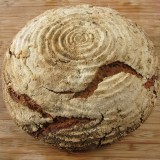I’ve been really enjoying homemade seasoned salt lately, especially herb and conifer salts, but also just plain old garlic salt. For me, garlic salt sort of snuck under my DIY radar. If a recipe calls for garlic salt, you reach for the beige stuff in the jar, right? Well, no, actually, it turns out you can make it yourself in two minutes. I honestly don’t know why it took me so long to figure this out.
All you have to do is chop any aromatic, like garlic or herbs or citrus zest, into salt, mincing it with a big kitchen knife until it reaches a texture you like. That might be very fine, or a little rough. You could do this more quickly in a food processor. I use kosher salt for this, you could use a fancier salt if you like.
When you’re done, you spread the salt on a plate and leave it out to dry for a day or two. The salt really accelerates the dry time. Then transfer it to a jar. That’s all there is to it.
The only decisions to make are which aromatics you’re going to try–I’ll give some suggestions below–and what your salt to aromatic ratio is going to be. I can’t give you an exact recipe–it’s something you’ve got to feel out for yourself, knowing all the while that whatever you make will be okay.
Many herb salt recipes suggest equal parts herb and salt, but I often use much less salt than that. The question you must ask is whether you want your end product to be salt which is lightly flavored, or flavor chunks of some aromatic which are enhanced by salt–that is to say, herbed salt or salted herb?
The best approach is to simply start with less salt and see how it goes, because you can always add more.
A Tale of Two Salts
To give you some concrete examples, I made two small batches of salt today. I often make herbed salt in tiny batches that get used up quickly, because I like to experiment.
The first one I made was with spruce tips. These are the fresh spring growth of a fir tree, the tender chartreuse tips which stand out in such brilliant contrast to the tree’s older foliage. They have a subtle citrus-pine flavor. I only had a handful to work with–I’d like to get more if I can get up to the mountains again soon.
I felt like the spruce was the real star of this blend. I didn’t want its subtle flavor overwhelmed by salt, so I used very little salt.
I also had a bit of pine to work with. I’d been in the mountains for the day, and had been nibbling on every pine I saw, like a lunatic. [See the end for an obligatory safety warning.]
There is surprising flavor variation among conifers, even between trees of the same type growing right next to one another. Moreover, the flavor of a particular tree will fluctuate over the course of the year. If you’re looking for edible pine, you just have to taste test until you find something nice. Most of the pines I found on this outing were really dry despite the season–thank you, drought– and tasted bland or unpleasant. I found one tree which had a decent flavor, and brought home a single cluster of needles.
In this case, I decided the pine flavor was not interesting enough to be the star of the recipe, but I thought it would add a nice twist for garlic salt.
Most herbs, including the soft spruce tips, will sort of blend and mash into the salt, creating a uniform, sandy texture. Pine needles are too tough for that, so the best you can do with them is to chop them into very fine pieces then mix them into the salt. They will infuse the salt with flavor as they sit in it, but will always remain distinct, and if the pieces are too big, it can be unpleasant.
After I minced the needles, I minced some garlic into the salt as well. Chop the garlic about as fine as your patience lasts, keeping in mind that it shrinks when it dehydrates, so it doesn’t have to be super-fine to start.
You can see in these pictures that the garlic/pine salt is much whiter, i.e. much more salt heavy. The spruce tips, meanwhile, are all about the green.
Other Herbed Salt Ideas
Get creative. You can chop almost anything you like into salt:
• Herbs of all types–dill, sage, parsley, basil, etc. You can recreate classic herb combos, like Herbs de Provence.
• I haven’t made onion or shallot salt yet, but am wondering why I haven’t.
• Straight garlic salt is easy and useful
• Citrus zest is lovely with salt
• A nice fresh spicy red pepper would make an interesting salt
• Various combinations of the above seem suggestive: citrus and hot pepper, onion and parsley, etc.
• Lavender salt can be really nice if used sparingly on sweets, like caramel or shortbread or chocolate
• Stinging nettles don’t taste like much, but they have lots of nutritional value. Make a healthy green salt with fresh or dry nettles (For fresh, use a food processor, or wear gloves as you chop! The stingers will fade when the plant dries out.)
• Seaweed salt. Add some sesame seeds for furikake-like flavor
• My favorite salt so far has been piñon pine with garlic. I need me some more piñon!
What do you do with it?
Herbed salts are nice on vegetables and popcorn. They can add that extra oomph to soups and stews. They can be used as meat rubs. They can be kept at table and sprinkled on everything.
Regarding pine toxicity
There was a single study that showed that eating Ponderosa pine tips caused miscarriages in cattle, and if the cattle ate huge amounts of Ponderosa pine, they suffered other illnesses. This gets waved around and scares people from eating pine. In contrast to this is a long tradition of humans brewing and drinking pine needle tea in perfect safety. It is my understanding that all true pines (Pinus) are considered edible.
As usual, the answer is all things in moderation. Don’t eat tons of pine. Easily done! It’s not that tasty. And to be absolutely safe, skip pine entirely while you’re pregnant.
In addition, know how to identify two truly toxic trees you might run into, and definitely don’t want to eat: The Australian Pine, also known as Norfolk Pine and the Yew. Neither are actually pines–they’re not members of the Pinus family–but they are sometimes thought of as pines.









Thank you for salty herb and conifer ideas! Angeles Crest Creamery posted a piñon pine syrup recipe that looks delicious, but I’m not eating any sugar right now. You’ll have to visit Angeles Crest Creamery for piñon pine!
Yes! Pinon pine -and- lots of cute goats!
I just got back from the mountains (Svanetia) in Georgia (the one in the Caucasus)… they prepare a delicious varenie (boiled sugar syrup & whole fruit–typical product for the whole post-Soviet world) using tiny pine cones… The cones are so small I thought they were blackberries. I saw these pine cones everywhere on the paths in the mountains… I’m not sure if the ones used to make the varenie are picked green and young. Maybe you can use them at any stage, so long as they’re boiled awhile? Anyway, delicious, slightly resinous with citrus highlights… especially great stirred into tea. And apparently a pretty normal thing there, and no one mentioned a thing about toxicity.
Thank you! I’ve been curious about tiny cones. I’ve made pine syrup with sugar and needles, and it’s really nice.
Could those tiny pine cones be Juniper “berries”? (The “berries” are actually the fruit/cone of the plant.)These are used in cookery. Boiling in sugar syrup sounds interesting.